Mangroves, Mud and Myopics

Mud, mud, glorious mud,
Nothing quite like it for cooling the blood.
So follow me, follow,
Down to the hollow,
And there let us wallow in glo-o-o-orious mud.The Hippopotamus Song by Flanders and Swan

No hippopotami convening in my neck of the woods, but I do have an affinity with, or rather a passion for, mud.
Living near the coast in Queensland, in the northern (and therefore warm and tropical to subtropical) top half of Australia, means access to good beaches and warm water. But coastal areas in warm climes also mean the presence of coastal rivers, estuaries and bays, with large deposits of mud, where you'll find mud, and where you'll also find ..... the magnificent mangrove forest.
Here in Oz we have just under 12,000 square kilometres (approximately 5,000 square miles) of mangroves, of which just under 5,000 square kilometres are located along the Queensland coast.
Over the last few decades, mangrove environments, worldwide, have been disappearing. This is due to a number of factors, including the following:
- overenthusiastic coastal development, often verging on ignorance, with so called man-made construction and decimation of mangroves often being seen as an 'improvement', particularly in areas of naturally intertidal acid sulfate muddy soil, where the occasional natural 'whiff' of hydrogen sulphide (rotten eggs gas) is misinterpreted as a decaying, instead of healthy, environment;

- exploitation of the timber as a source of fuel wood; and
- perhaps the historically most common and important reason for removing the mangrove, for its bark, which is peeled to extract tannin, used as a dye in the leather industry.
It follows that many of our planet's coastal developers, along with many of the 'worldly-wise' planners, upon whom we depend to provide guidance and controls for development, often demonstrate a complete lack of understanding of the importance of .....
" ..... the structure and function of mangrove communities, their value and the need for conservation of this often underestimated resource."
Catherine Lovelock in "Field Guide to the Mangroves of Queensland"
- Is this just another pitiful and unsustained call to arms from the green movement?
- What are the benefits, if any, of these muddy coastal ecosystems, so obviously inclement and alien to our preferred human performance palette of dry solid stable ground? and
- What happens when we remove and 'improve' this soggy wet impenetrable maze of coastal leafy clutter?

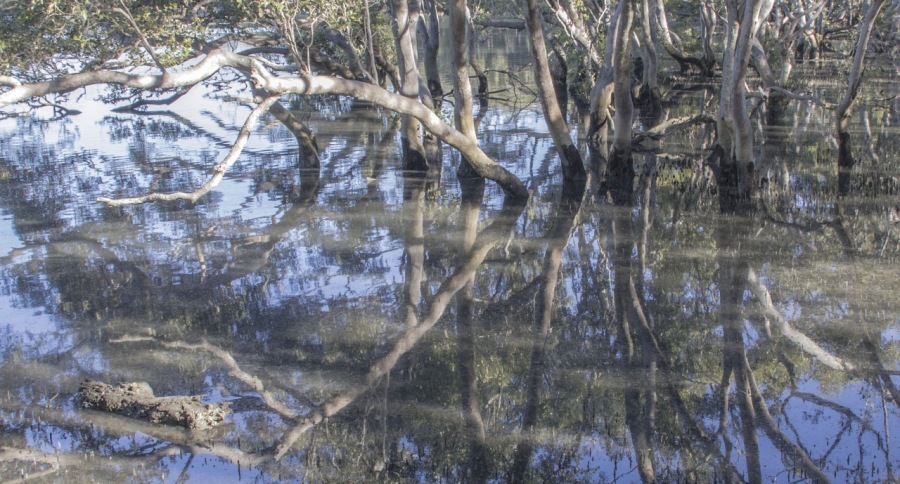
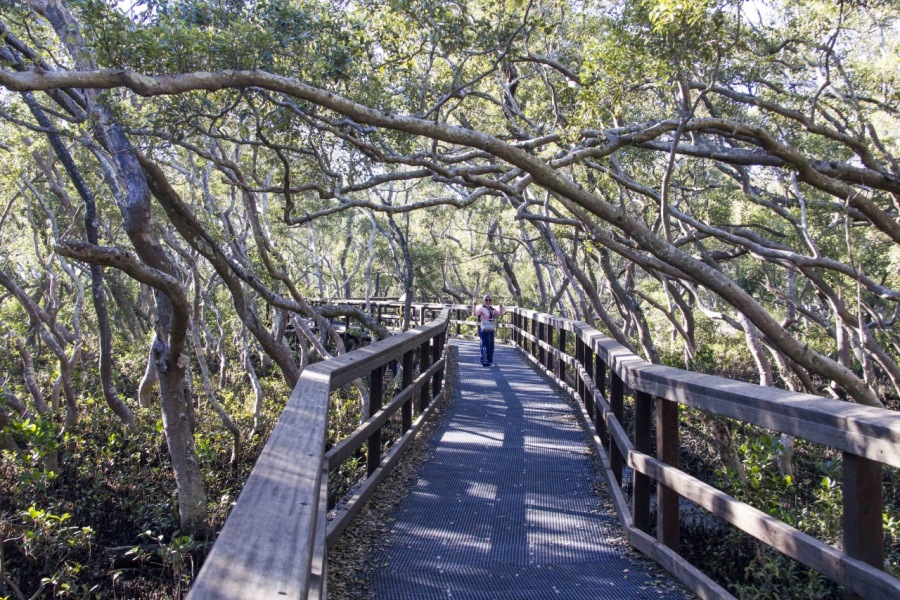

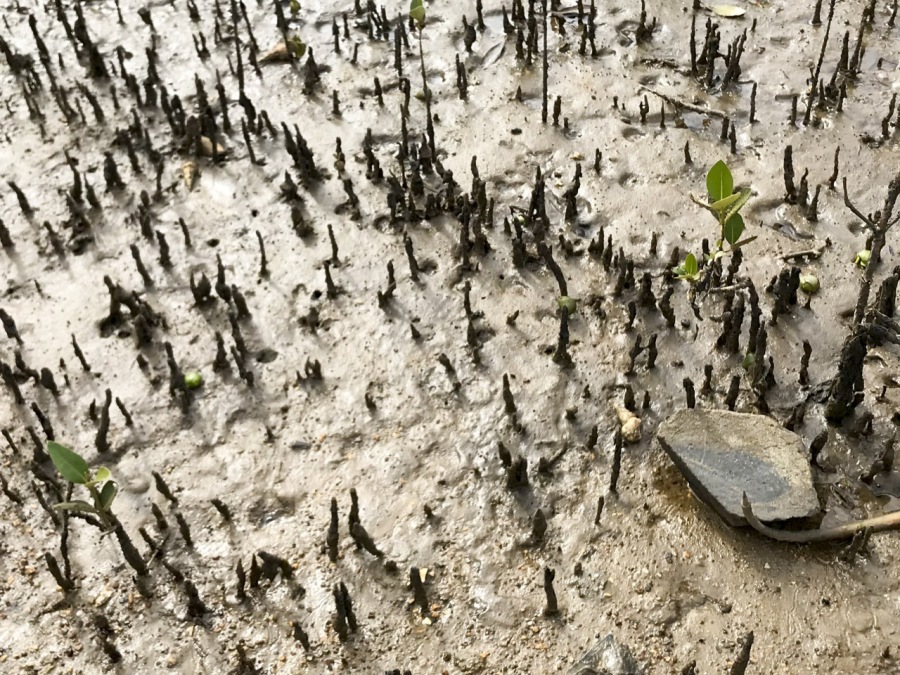


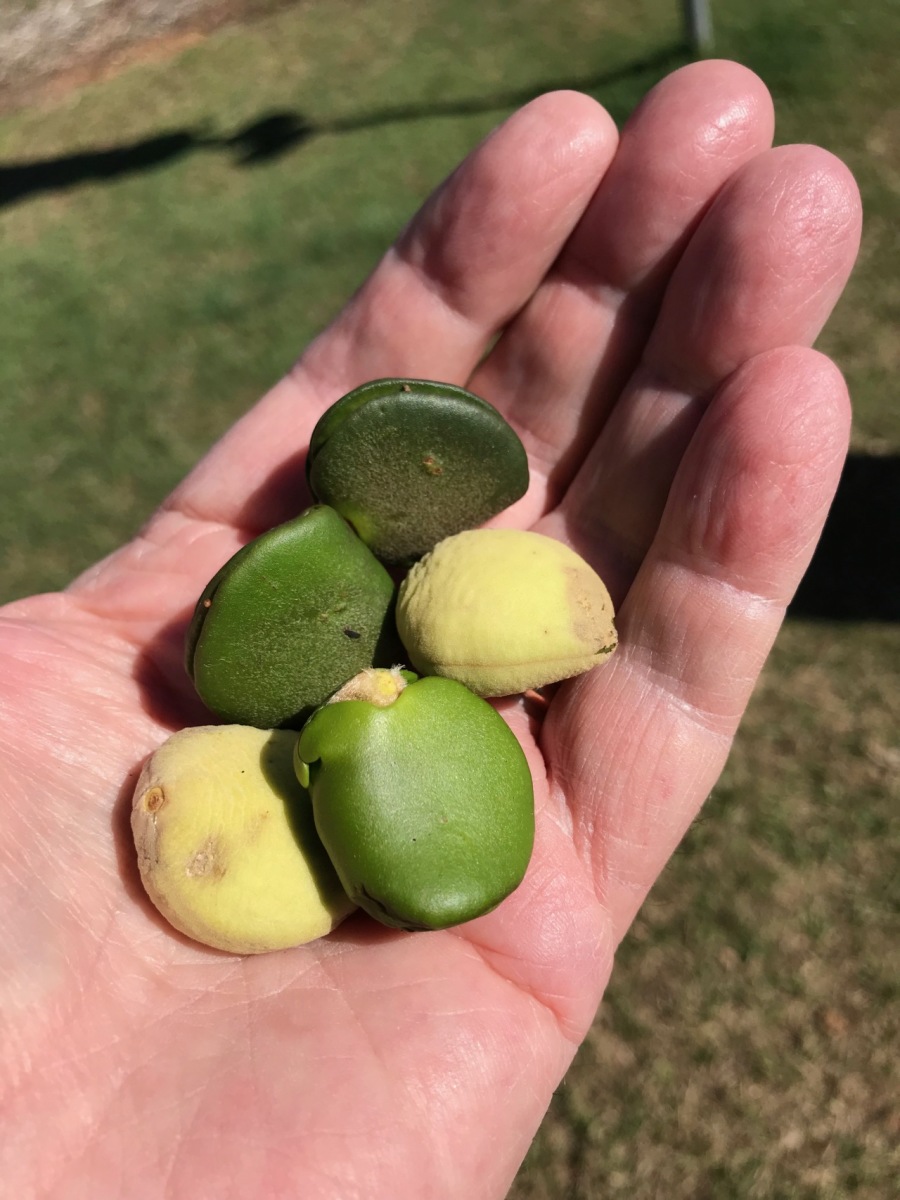


A teaspoon of mud from a north Queensland mangrove forest contains more than 10 billion bacteria. These densities are among the highest to be found in marine mud anywhere in the world and are an indication of the immensely high productivity of this coastal habitat.
- WetlandInfo Dept of Environment and Science, Queensland
These bacteria interact with leaf litter and fungi, present within the mangrove mud 'garden', and are a food source for crabs, fish and prawns. These marine creatures, in turn, produce waste which contributes to the nourishment of molluscs and small crustaceans, and, when the waste goes into solution, plankton are nourished. And so the food chain goes round and round, and includes worms and other small 'fisherman bait' towards the bottom end, with wading birds and sea birds at the heavier and more readily visible end, as pictorially presented in this slide 'borrowed' from an unreferenced source while surfing the net.
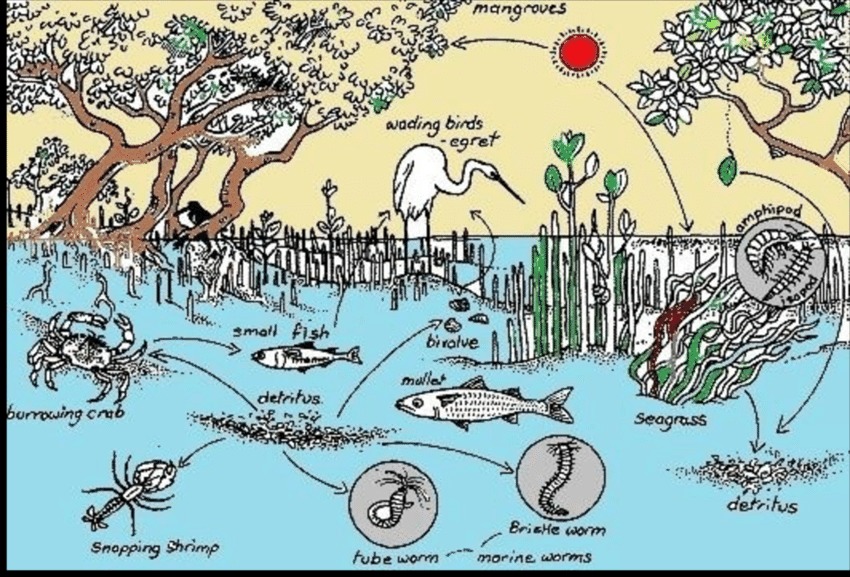
If you take some time out to peruse the following shots, taken while I was exploring the various more sheltered parts of the Brisbane shoreline, I think you'll "get the picture" of some of the diverse community dependent upon the Moreton Bay mangroves. But please bear in mind that this is only a very small sample of some of the vibrant bird and aqueous wildlife, which either depends upon, or comes to visit, the many trees, shrubs and occasional palms which comprise the mangrove forest.


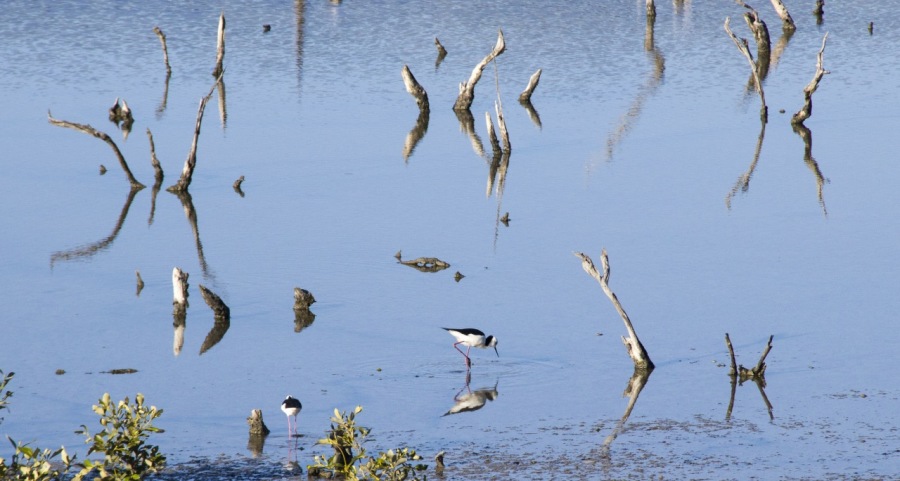

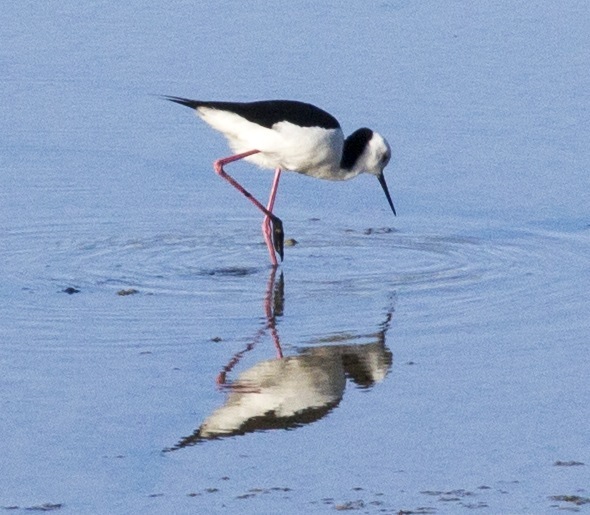
So if we remove the mangroves we tamper with a large and vibrant, although mostly hidden, food chain. Furthermore, the humble mangrove provides some protection to the shoreline against storm-driven waves and wind. This protection tends to come more into play against major storm events and sea level surges, as mangroves naturally establish themselves along sheltered bays in shallow water where sustainable mud gathers readily. Here are two of the more obvious examples of this protection in the northern part of Australia:
- In 1974, when Cyclone Tracy decimated Darwin, the only two yachts left undamaged were sheltering in a mangrove creek.
- In 2006, when Cyclone Larry set upon Far North Queensland, the mangroves again protected many vessels and stretches of coastline, and the damage bill would have been considerably higher if it wasn't for the presence of intact mangrove forests.

Photographs

http://ken-boddie.squarespace.com
The author of the above, Ken Boddie, besides being a sometime poet and occasional writer, is an enthusiastic photographer, rarely leisure-travelling without his Canon, and loves to interact with other like-minded people with diverse interests.
Ken's three day work week (part time commitment) as a consulting engineer allows him to follow his photography interests, and to plan trips to an ever increasing list of countries and places of scenic beauty and cultural diversity.
Articles from Ken Boddie
View blog
There's a part of Australia I've seen now and then, · Where the folks are resilient, both women and ...

How an opportune afternoon, aimed at attuning a young mind to the good old Disney cartoons, turned i ...

Let's talk about how we manage reproduction, by which I mean the following processes: · Desiring to ...
Related professionals
You may be interested in these jobs
-
Prestige Sales Executive
Found in: Talent AU C2 - 1 day ago
LSH Auto Australia Southbank, AustraliaPrestige Sales Executive | Mercedes-Benz Melbourne · Awarded AFR BOSS Best Places to Work 2022, Mercedes-Benz Melbourne is seeking a driven & motivated Product Sales Executive to join our Kings Way team. · The Role: · Achieving sales & profit targets · Maintaining product knowled ...
-
Fertiliser Depot Sales and logistics
Found in: Talent AU C2 - 1 day ago
AG Warehouse Koroit, Australia Full timeAt Saputo, our best comes from our people. We're a talented and caring team with a longstanding history of excellence. Since our first days delivering cheese on a bicycle, we've grown into a leading global dairy processor by staying true to the culture that defines us. Each of ou ...
-

Endorsed Enrolled Nurse
Found in: Talent AU C2 - 4 days ago
Mercy Health Richmond, Australia PermanentOur 96 bedded healthy ageing facility Mercy Place Shepparton on Archer Street is seeking qualified Endorsed Enrolled Nurses to join their team on a part time or casual basis. · ABOUT THE ROLE: · Part time and Casual positions available · Provide quality resident-focused care util ...



Comments
Ken Boddie
5 years ago #23
Thanks for dropping by, Emilie. 👍
Lada 🏡 Prkic
5 years ago #22
Thanks, I've already read some additional articles. One thing also, mangrove forests teach us if something smells like rotten eggs could be the sign of a healthy environment. 🤢😂
Ken Boddie
5 years ago #21
I can see that I'm preaching to the converted, Lada \ud83c\udfe1 Prkic. 👍 If you're interested in reading more environmental posts, try some of the writings of Yessenia Funes, accessed via Alexa Steele's comment #12 below.
Lada 🏡 Prkic
5 years ago #20
Ken Boddie
5 years ago #19
We all have choices, . The trouble is if we run with the pack then we’ll habitually lift our leg on Mother Earth.
🐝 Fatima G. Williams
5 years ago #18
Well Ken Boddie I just checked and we are still on earth and there is very little chance of that happening. Forget seeing beauty in nature, people don't look at people for their inner beauty anymore! It's all about money, success etc
Ken Boddie
5 years ago #17
Paul Walters. Thanks for the thumbs up, Pak Paul. But we careful when stats are thrown around by some. As they say, “there are lies, damned lies, and statistics!” 🤣
Ken Boddie
5 years ago #16
Many thanks, Franci\ud83d\udc1dEugenia Hoffman, beBee Brand Ambassador. I just wish more people would see the beauty rather than the bounty.
Ken Boddie
5 years ago #15
True, . If we make Mother Nature cry often enough and long enough, we’ll eventually drown in her tears.
Paul Walters
5 years ago #14
🐝 Fatima G. Williams
5 years ago #13
Ken Boddie
5 years ago #12
Many thanks, Alexa Steele, for introducing me to the posts of Yessenia Funes, who appears to be a prolific writer on various envro issues. 👍 Incidentally those giant red mangroves would appear to be a poor choice (from the many mangrove species available) for sediment retention in Hawaii, because of their massive stilted roots, much better suited for shore protection against the onset of waves. Yet another example of unforeseen results from our dabbling with nature, by introducing retrospectvely inappropriate flora or fauna into one region from another. Here in Oz we are task masters at such blunders, what with gorse bushes and other rampant growth weeds, the pesky rabbit, feral cat, and of course the cane toad (which has us all hopping mad). 😡
Ken Boddie
5 years ago #11
interesting take on ‘preservation’, Alexa. I’ll have a look at your video later.
Ken Boddie
5 years ago #10
Hey Jennifer ..... Well thank you, my lady, I hope you don’t mind, When I say perhaps maybe, Your words are too kind. ☺️
Ken Boddie
5 years ago #9
Great comment, Ian, and so ...... When those roots are in flood, They’re sure “clear as mud”, And that’s how it is every day, But my cautionary tale, I trust will not fail, So the moral remains “clear as day”.
Ian Weinberg
5 years ago #8
Ken Boddie
5 years ago #7
It's never too late to get in on the action, Joel. I guess that the title "Magdalena Mangroves" has a certain ring to it. Now we've read the book, let's watch the movie, followed by a late night snack of soft shell crab. 🦀
Ken Boddie
5 years ago #6
Hey Pascal ..... I can see they were miffed, 'Hi Po' guys missed your drift, And, somehow, it just isn't fair, But I guess when you spoke, With that lame Hippo joke, They forgot that it's hip to be square. 🤗
Joel Anderson
5 years ago #5
Joel Anderson
5 years ago #4
Pascal Derrien
5 years ago #3
Ken Boddie
5 years ago #2
Many thanks, Debasish. I trust you are presbiopic. 🤣
Debasish Majumder
5 years ago #1